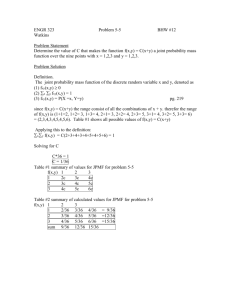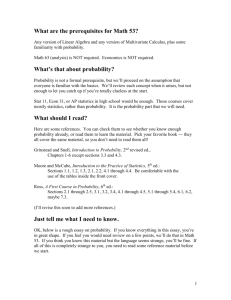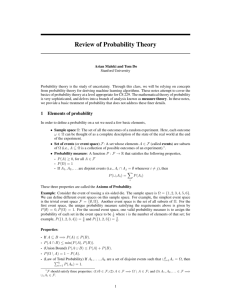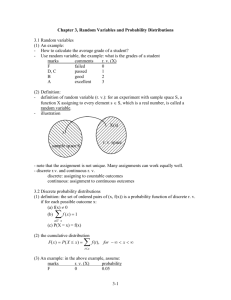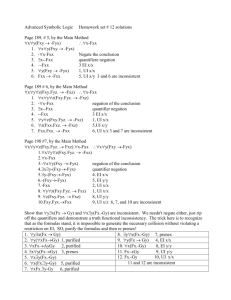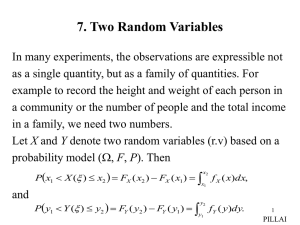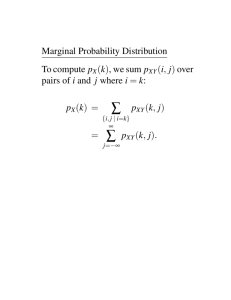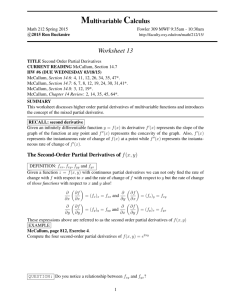Chapter 5: JOINT PROBABILITY DISTRIBUTIONS Part 1: Sections 5
advertisement
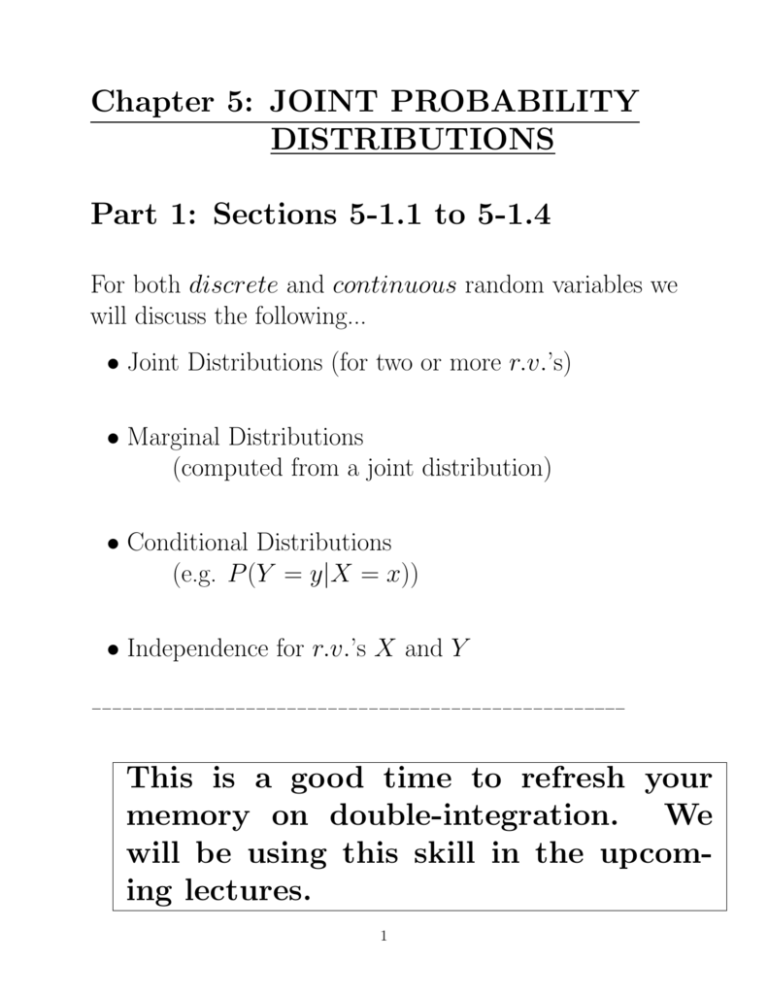
Chapter 5: JOINT PROBABILITY
DISTRIBUTIONS
Part 1: Sections 5-1.1 to 5-1.4
For both discrete and continuous random variables we
will discuss the following...
• Joint Distributions (for two or more r.v.’s)
• Marginal Distributions
(computed from a joint distribution)
• Conditional Distributions
(e.g. P (Y = y|X = x))
• Independence for r.v.’s X and Y
This is a good time to refresh your
memory on double-integration. We
will be using this skill in the upcoming lectures.
1
Recall a discrete probability distribution (or
pmf ) for a single r.v. X with the example below...
0
1
2
x
f (x) 0.50 0.20 0.30
Sometimes we’re simultaneously interested in
two or more variables in a random experiment.
We’re looking for a relationship between the two
variables.
Examples for discrete r.v.’s
• Year in college vs. Number of credits taken
• Number of cigarettes smoked per day vs. Day
of the week
Examples for continuous r.v.’s
• Time when bus driver picks you up vs.
Quantity of caffeine in bus driver’s system
• Dosage of a drug (ml) vs. Blood compound
measure (percentage)
2
In general, if X and Y are two random variables,
the probability distribution that defines their simultaneous behavior is called a joint probability
distribution.
Shown here as a table for two discrete random
variables, which gives P (X = x, Y = y).
x
1 2 3
1 0 1/6 1/6
y 2 1/6 0 1/6
3 1/6 1/6 0
Shown here as a graphic for two continuous random variables as fX,Y (x, y).
3
If X and Y are discrete, this distribution can be
described with a joint probability mass function.
If X and Y are continuous, this distribution can
be described with a joint probability density function.
• Example: Plastic covers for CDs
(Discrete joint pmf)
Measurements for the length and width of a
rectangular plastic covers for CDs are rounded
to the nearest mm (so they are discrete).
Let X denote the length and
Y denote the width.
The possible values of X are 129, 130, and
131 mm. The possible values of Y are 15 and
16 mm (Thus, both X and Y are discrete).
4
There are 6 possible pairs (X, Y ).
We show the probability for each pair in the
following table:
x=length
129 130 131
y=width 15 0.12 0.42 0.06
16 0.08 0.28 0.04
The sum of all the probabilities is 1.0.
The combination with the highest probability is (130, 15).
The combination with the lowest probability
is (131, 16).
The joint probability mass function is the function fXY (x, y) = P (X = x, Y = y). For
example, we have fXY (129, 15) = 0.12.
5
If we are given a joint probability distribution
for X and Y , we can obtain the individual probability distribution for X or for Y (and these
are called the Marginal Probability Distributions)...
• Example: Continuing plastic covers for CDs
Find the probability that a CD cover has
length of 129mm (i.e. X = 129).
x= length
129 130 131
y=width 15 0.12 0.42 0.06
16 0.08 0.28 0.04
P (X = 129) = P (X = 129 and Y = 15)
+ P (X = 129 and Y = 16)
= 0.12 + 0.08 = 0.20
What is the probability distribution of X?
6
x= length
129 130
y=width 15 0.12 0.42
16 0.08 0.28
column totals
0.20 0.70
131
0.06
0.04
0.10
The probability distribution for X appears
in the column totals...
x
129 130 131
fX (x) 0.20 0.70 0.10
∗
NOTE: We’ve used a subscript X in the probability
mass function of X, or fX (x), for clarification since
we’re considering more than one variable at a time
now.
7
We can do the same for the Y random variable:
row
x= length
totals
129 130 131
y=width 15 0.12 0.42 0.06 0.60
16 0.08 0.28 0.04 0.40
column totals
0.20 0.70 0.10
1
y
15 16
fY (y) 0.60 0.40
Because the the probability mass functions for
X and Y appear in the margins of the table
(i.e. column and row totals), they are often referred to as the Marginal Distributions for
X and Y .
When there are two random variables of interest, we also use the term bivariate probability distribution or bivariate distribution
to refer to the joint distribution.
8
• Joint Probability Mass Function
The joint probability mass function of the discrete random variables X and Y , denoted as
fXY (x, y), satisfies
(1) fXY (x, y) ≥ 0
XX
(2)
fXY (x, y) = 1
x
y
(3) fXY (x, y) = P (X = x, Y = y)
For when the r.v.’s are discrete.
(Often shown with a 2-way table.)
x= length
129 130 131
y=width 15 0.12 0.42 0.06
16 0.08 0.28 0.04
9
• Marginal Probability Mass Function
If X and Y are discrete random variables
with joint probability mass function fXY (x, y),
then the marginal probability mass functions
of X and Y are
fX (x) =
X
fXY (x, y)
y
and
fY (y) =
X
fXY (x, y)
x
where the sum for fX (x) is over all points in
the range of (X, Y ) for which X = x and the
sum for fY (y) is over all points in the range
of (X, Y ) for which Y = y.
We found the marginal distribution for X in the
CD example as...
x
129 130 131
fX (x) 0.20 0.70 0.10
10
HINT: When asked for E(X) or V (X) (i.e. values related to only 1 of the 2 variables) but you
are given a joint probability distribution, first
calculate the marginal distribution fX (x) and
work it as we did before for the univariate case
(i.e. for a single random variable).
• Example: Batteries
Suppose that 2 batteries are randomly chosen without replacement from the following
group of 12 batteries:
3 new
4 used (working)
5 defective
Let X denote the number of new batteries
chosen.
Let Y denote the number of used batteries
chosen.
11
a) Find fXY (x, y)
{i.e. the joint probability distribution}.
b) Find E(X).
ANS:
a) Though X can take on values 0, 1, and 2,
and Y can take on values 0, 1, and 2, when
we consider them jointly, X + Y ≤ 2. So,
not all combinations of (X, Y ) are possible.
There are 6 possible cases...
CASE: no new, no used (so
! all defective)
5
2
! = 10/66
fXY (0, 0) =
12
2
12
CASE: no new, 1 used !
!
4
5
1
1
! = 20/66
fXY (0, 1) =
12
2
CASE: no new, 2 used !
4
2
! = 6/66
fXY (0, 2) =
12
2
CASE: 1 new, no used !
!
3
5
1
1
!
= 15/66
fXY (1, 0) =
12
2
13
CASE: 2 new, no used !
3
2
! = 3/66
fXY (2, 0) =
12
2
CASE: 1 new, 1 used
3
1
fXY (1, 1) =
!
4
1
12
2
!
!
= 12/66
The joint distribution for X and Y is...
x= number of new chosen
0
1
2
y=number of 0 10/66 15/66 3/66
used 1 20/66 12/66
chosen 2
6/66
ThereP
are P
6 possible (X, Y ) pairs.
And, x y fXY (x, y) = 1.
14
b) Find E(X).
15
• Joint Probability Density Function
A joint probability density function for the
continuous random variable X and Y , denoted as fXY (x, y), satisfies the following
properties:
1. fXY (x, y) ≥ 0 for all x, y
R∞ R∞
2. −∞ −∞ fXY (x, y) dx dy = 1
3. For any region R of 2-D space
Z Z
P ((X, Y ) ∈ R) =
fXY (x, y) dx dy
R
For when the r.v.’s are continuous.
16
• Example: Movement of a particle
An article describes a model for the movement of a particle. Assume that a particle
moves within the region A bounded by the x
axis, the line x = 1, and the line y = x. Let
(X, Y ) denote the position of the particle at
a given time. The joint density of X and Y
is given by
fXY (x, y) = 8xy
for
(x, y) ∈ A
a) Graphically show the region in the XY
plane where fXY (x, y) is nonzero.
17
b) Find P (0.5 < X < 1, 0 < Y < 0.5)
c) Find P (0 < X < 0.5, 0 < Y < 0.5)
18
d) Find P (0.5 < X < 1, 0.5 < Y < 1)
19
• Marginal Probability Density
Function
If X and Y are continuous random variables
with joint probability density function fXY (x, y),
then the marginal density functions for X and
Y are
Z
fX (x) =
and
y
fXY (x, y) dy
Z
fY (y) =
x
fXY (x, y) dx
where the first integral is over all points in
the range of (X, Y ) for which X = x, and
the second integral is over all points in the
range of (X, Y ) for which Y = y.
HINT: E(X) and V (X) can be obtained by
first calculating the marginal probability distribution of X, or fX (x).
20
• Example: Movement of a particle
An article describes a model for the movement of a particle. Assume that a particle
moves within the region A bounded by the x
axis, the line x = 1, and the line y = x. Let
(X, Y ) denote the position of the particle at
a given time. The joint density of X and Y
is given by
fXY (x, y) = 8xy
a) Find E(X)
21
for
(x, y) ∈ A
22
Conditional Probability Distributions
As we saw before, we can compute the conditional probability of an event given information
of another event.
As stated before,
P (A∩B)
P (A|B) = P (B)
• Example: Continuing the plastic covers...
row
x= length
totals
129 130 131
y=width
15 0.12 0.42 0.06 0.60
16 0.08 0.28 0.04 0.40
column totals
0.20 0.70 0.10
1
a) Find the probability that a CD cover has
a length of 130mm GIVEN the width is
15mm.
23
x= length
129 130
y=width
15 0.12 0.42
16 0.08 0.28
column totals
0.20 0.70
row
totals
131
0.06
0.04
0.10
ANS: P (X = 130|Y = 15) =
0.60
0.40
1
P (X=130,Y =15)
P (Y =15)
= 0.42/0.60 = 0.70
b) Find the conditional distribution of X
given Y =15.
P (X = 129|Y = 15) = 0.12/0.60 = 0.20
P (X = 130|Y = 15) = 0.42/0.60 = 0.70
P (X = 131|Y = 15) = 0.06/0.60 = 0.10
24
Once you’re GIVEN that Y =15, you’re in a
‘different space’.
We are now considering only the CD covers
with a width of 15mm. For this subset of the
covers, how are the lengths (X) distributed.
The conditional distribution of X given Y =15,
or fX|Y =15(x):
x
129 130 131
fX|Y =15(x) 0.20 0.70 0.10
Notice that the sum of these probabilities is
1, and this is a legitimate probability distribution .
∗ NOTE: Again, we use the subscript X|Y for clarity
to denote that this is a conditional distribution.
25
• Conditional Probability Distributions
Given random variables X and Y with joint
probability fXY (x, y), the conditional
probability distribution of Y given X = x is
f
(x,y)
fY |x(y) = XY
fX (x)
for
fX (x) > 0.
The conditional probability can be stated as
the joint probability over the marginal probability.
Notice that we can define fX|y (x) in a similar manner if we are interested in that conditional distribution.
26
Because a conditional probability distribution fY |x(y) is a legitimate probability distribution, the following properties are satisfied:
• For discrete random variables (X,Y)
(1) fY |x(y) ≥ 0
(2)
X
fY |x(y) = 1
y
(3) fY |x(y) = P (Y = y|X = x)
• For continuous random variables (X,Y)
1. fY |x(y) ≥ 0
R∞
2. −∞ fY |x(y) dy = 1
R
3. P (Y ∈ B|X = x) = B fY |x(y) dy
for any set B in the range of Y
27
• Conditional Mean and Variance
for discrete random variables
The conditional mean of Y given X = x, denoted as E(Y |x) or µY |x is
X
E(Y |x) =
yfY |X (y)
y
= µY |x
and the conditional variance of Y given X =
x, denoted as V (Y |x) or σY2 |x is
X
V (Y |x) =
(y − µY |x)2fY |X (y)
y
=
X
y 2fY |X (y) − µ2Y |x
y
= E(Y 2|x) − [E(Y |x)]2
= σY2 |x
28
• Example: Continuing the plastic covers...
x=length
129 130
y=width
15 0.12 0.42
16 0.08 0.28
column totals
0.20 0.70
row
totals
131
0.06
0.04
0.10
0.60
0.40
1
a) Find the E(Y |X = 129) and
V (Y |X = 129).
ANS:
We need the conditional distribution first...
y
15
16
fY |X=129(y)
29
30
• Conditional Mean and Variance
for continuous random variables
The conditional mean of Y given X = x,
denoted as E(Y |x) or µY |x, is
E(Y |x) =
R
yfY |x(y) dy
and the conditional variance of Y given X =
x, denoted as V (Y |x) or σY2 |x, is
V (Y |x) = (y − µY |x)2fY |x(y) dy
R
R 2
= y fY |x(y) dy − µ2Y |x
31
• Example 1: Conditional distribution
Suppose (X, Y ) has a probability density function...
fXY (x, y) = x + y for 0 < x < 1, 0 < y < 1
a) Find fY |x(y).
R∞
b) Show −∞ fY |x(y)dy = 1.
32
a)
33
b)
One more...
c) What is the conditional mean of Y given
X = 0.5?
ANS:
First get fY |X=0.5(y)
x+y
fY |x(y) =
x + 0.5
for 0 < x < 1 and 0 < y < 1
0.5 + y
fY |X=0.5(y) =
= 0.5 + y
0.5 + 0.5
Z 1
for
7
E(Y |X = 0.5) =
y(0.5 + y) dy =
12
0
34
0<y<1
Independence
As we saw earlier, sometimes, knowledge of one
event does not give us any information on the
probability of another event.
Previously, we stated that if A and B were independent, then
P (A|B) = P (A).
In the framework of probability distributions,
if X and Y are independent random variables,
then fY |X (y) = fY (y).
35
• Independence
For random variables X and Y , if any of the
following properties is true, the others are
also true, and X and Y are independent.
(1) fXY (x, y) = fX (x)fY (y)
for all x and y
(2) fY |x(y) = fY (y)
for all x and y with fX (x) > 0
(3) fX|y (x) = fX (x)
for all x and y with fY (y) > 0
(4) P (X ∈ A, Y ∈ B) = P (X ∈ A) · P (Y ∈ B)
for any sets A and B in the range of X and Y.
Notice how (1) leads to (2):
fXY (x,y)
fX (x)fY (y)
fY |x(y) = f (x) = f (x) = fY (y)
X
X
36
• Example 1: (discrete)
Continuing the battery example
Two batteries were chosen without replacement.
Let X denote the number of new batteries
chosen.
Let Y denote the number of used batteries
chosen.
x= number of new chosen
0
1
2
y=number 0 10/66 15/66 3/66
of used 1 20/66 12/66
chosen 2
6/66
a) Without doing any calculations, can you
tell whether X and Y are independent?
37
• Example 2: (discrete)
Independent random variables
Consider the random variables X and Y ,
which both can take on values of 0 and 1.
row
totals
x
y 0
1
column totals
0
0.08
0.72
0.80
1
0.02
0.18
0.20
0.10
0.90
1
a) Are X and Y independent?
y
fY |X=0(y)
38
0
1
y
fY |X=1(y)
0
1
Does fY |x(y) = fY (y) for all x & y?
Does fXY (x, y) = fX (x)fY (y) for all x & y?
row
totals
x
y 0
1
column totals
0
0.08
0.72
0.80
1
0.02
0.18
0.20
0.10
0.90
1
i.e. Does P (X = x, Y = y)
= P (X = x) · P (Y = y)?
39
• Example 3: (continuous)
Dimensions of machined parts (Example 512).
Let X and Y denote the lengths of two dimensions of a machined part.
X and Y are independent and measured in
millimeters (you’re given independence here).
X ∼ N (10.5, 0.0025)
Y ∼ N (3.2, 0.0036)
a) Find
P (10.4 < X < 10.6, 3.15 < Y < 3.25).
40
